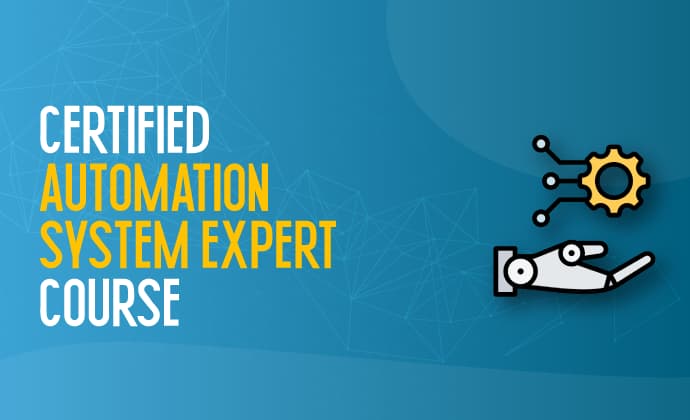
Course Details
Ready to unlock the power of automation? Are you looking to propel your career in industrial automation, this is the perfect place to start.
Forget generic courses! This engaging program equips you with the in-demand skills and knowledge to thrive in Pakistan's booming automation industry.
Here's what sets this automation training apart:
- Developed for YOU: This course is specifically designed to meet the needs of the automation market, ensuring you learn the most relevant technologies and practices.
- Hands-on Learning: Go beyond theory with practical labs and real-world scenarios, mastering the tools you'll use every day.
- Industry-Leading Curriculum: Stay ahead of the curve with a curriculum that covers the latest automation trends and technologies.
Deep Dive into Industrial Automation:
- PLC Power: Unlock the secrets of Programmable Logic Controllers (PLCs), the workhorses of industrial automation.
- HMI Expertise: Master Human-Machine Interfaces (HMIs), the essential communication link between humans and machines.
- Sensor Savvy: Learn how sensors gather critical data, the foundation of any effective automation system.
- Actuator Advantage: Discover how actuators put automation into action, driving machinery and processes.
- And More! Explore a comprehensive range of automation components and their role in creating seamless, efficient systems.
Why Choose This Course?
- Become an Automation Pro: Develop the skills and knowledge to excel in a high-demand field.
- Future-Proof Your Career: Stay relevant in the ever-evolving world of automation.
- Boost Your Earning Potential: Command premium salaries as a skilled automation professional.
This course is ideal for:
- Engineers seeking to expand their skill set into automation
- Technicians looking to advance their careers
- Professionals transitioning into the automation field
Course Outcome:
Upon completing the Automation System Expert Course from IIPD, the candidate will be able to:
- Locate and identify hardware systems like PLC, HMI, VFD, PAC
- Program and configure different brands of PLCs and PACs per the process/site requirement.
- Interpret, understand, and apply ladder logic programming as per requirements and make changes to running programs
- Program and configure HMI and SCADA and communicate with PLCs.
- Program and setup VFDs for industrial applications
- Perform industrial networking using communication protocols like MODBUS 485, MODBUS TCP, PROFIBUS, etc, between PLC and slave modules.
- Troubleshoot Communication issues.
- Troubleshoot I/O Faults
- Going online with the software for monitoring and troubleshooting
- Understand and perform PLC-based Control Panel Wiring.
- Understand the Industrial Internet of Things (IIoT) technology, fetch data from PLC, and upload to the cloud-based system.
Prerequisite:
- Bachelor/Diploma In electrical/ electronics/ mechanical/ mechatronics/ instrumentation/ control/ robotics and minimum 2 years experience in a relevant technical field.
- Understanding of the systems to which the training is related.
Course Outline
Below is the course content, which includes a detailed outline of the topics and materials covered.
Introduction
- History of PLC
- Different Control Methods
- Relay, its application, and its features.
- Electrical wiring diagram of Gates using NO and NC Switches
- Implementation of Relay Gates
- Introduction to PLC and applications
- Advantage of PLC over relay wiring
- PLC Programming Languages
- General Introduction on SCADA, DCS
Allen Bradley PLC
- MicroLogix 1400 PLC Anatomy, Software Packages, and Versions
- Controller Properties, RSLogix500 First Look
- Input, Output Addressing, Memory allocation
- Configuring BOOTP DHCP tool for Communication
- Setting up RSLinx Classic Drivers, using RSEmulate for Program Simulation
- Controller and Program Tags
- Practice Questions and testing the program
- Creating interlocks for motor control
- Concepts of Timers-TON, TOF, RTO
- Concepts of Counters-CTU, CTD
- RTO RES
- Latch, Unlatch, OSR
- Uploading and Downloading program to the controller
- Online editing
- Advanced Math and Data conversion function
- Using Compare, Move and Limit functions
- Remaining instructions
- Configuring Analog IO
S7 1200 - SIEMENS PLC
- Siemens S7 series PLC Anatomy and Models
- Software Packages and Versions
- TIA Portal First Look
- Controller Properties
- Configuring Communication
- Selection of Controllers
- Input , output Addressing, and memory mapping
- Uploading and Downloading the program to the controller
- Creating new Project/Program and Tagname based Programming
- Basic Instructions
- Online editing
- Practice Questions
- Concepts of Timers - TON, TOF, TP, TONR
- Concepts of Counters - CTU, CTD, CTUD
- Using Compare, Move, and limit functions
- RTC
- Remaining instructions
- Configuring Analog IO
SCADA -InTouch (Schneider Electric)
- Introduction and application of SCADA
- Creating new project
- Basic drawing tools and color changing features
- Wizards
- Single switch and light with same tag
- Linking different tags using scripts
- On show, while show
- Automatic decrementing
- Animation properties – fill, location, orientation, size etc
- Condition scripts
- Data change scripts
- Trends(real time and historical)
- Key scripts
- Quick function
- Practice questions
- Remaining Features
- PLC - SCADA Interfacing
- Binary Output Interfacing
- Why Inputs cannot be controlled from SCADA.
- PLC Program and Interfacing
Programmable Automation Controller (PAC) -Allen Bradley
- ControlLogix Controller Anatomy
- RSLogix 5000 vs Studio 5000
- Addressing and memory allocation
- Bit logic Instructions
- Timer And Counter Instructions
- Compare instructions, Including CMP
- Mathematical instructions, Including CPT
- Using of arrays
- Using Compare, Move and Limit functions
- User User-defined types
- Industrial Application Practice Questions
Siemens HMI
- Select the HMI model
- Creating a new project
- Working with TIA portal for PLC tag communication
- Interfacing and communication settings
- PROFINET Network configuration
- Creating New Screens
- Screen Navigation
- Addressing and configuring Digital & Analog Tags
- Configuring Lamps, Switches & IO Field Elements
- Trends and Graphs
- User Security configuration
- Alarm Configuration
- Using other graphical elements
VFD (Danfoss)
- What is Local, 2-wire, and 3-wire? Control why and where it is used (explanation)
- Basic programming parameters and Local Control
- 2 wire control
- Analog Input Control
- Program Parameters
- Preset frequency using digital input
- Relay operation
- Display Parameters, Terminal Parameters
- 3 wire control
- Jogging using digital input
- All advanced Parameters (Eg:- Skip frequency, Start at power up)
- Other digital input parameters
- Automatic stopping of the motor when the frequency exceeds a predefined limit
- Practice Questions
Electrical Control Panel Wiring
- How can a relay replace PLC in small applications
- Switching of single output using relay
- AND,OR, NAND NOR gates
- XOR gate using double pole and then using single pole relay
- DOL starter
- The interlocking of two outputs using a relay(DOL)
- Contactors: working and applications
- DOL starter using contactor
- Timer 2 modes of operation On delay, Interval Delay
- Star delta starter wiring of 3 phase motor
- Alarm System problem using a relay with 3 poles and then reduced to 2 pole
- PLC Wiring
Industrial Communication Networks
- PROFIBUS
- MODBUS 485
- MODBUS TCP
Industrial Internet of Things (IIoT)-Basics
- Introduction to IIoT
- Acquiring Data from PLC
- Sending Data to the Cloud
Methodology:
- Batchwise and /or One on One Hands-on-Sessions
Ready to unlock a world of opportunity in Lahore's dynamic automation industry? This comprehensive course equips you with the skills and knowledge to confidently navigate the exciting world of industrial automation.
Course Curriculum

Ramzan
DeveloperI am a web developer with a vast array of knowledge in many different front end and back end languages, responsive frameworks, databases, and best code practices








